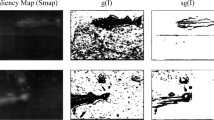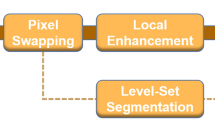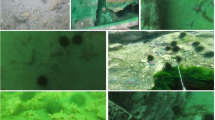Abstract
Underwater image detection remains a challenge due to problems such as noise, illumination inhomogeneity and low contrast. To solve these problems, this paper proposes a new level set segmentation model integrating saliency region detection (SDLSE). First, an underwater low-illumination saliency detection model is constructed and the target region is roughly segmented with the help of the saliency detection model to obtain pixel-level a prior shape information. Second, the a prior information is used as the shape constraint for finely segmenting the level set to improve the energy function of the level set. Based on the experimental data and fish dataset, the algorithm is statistically analyzed. It is verified that the segmentation effect of SDLSE model is better than other level sets in terms of segmentation accuracy and time efficiency.









Similar content being viewed by others
Data availability
Data underlying the results presented in this paper are not publicly available at this time but may be obtained from the authors upon reasonable request.
References
Achanta R, Susstrunk S (2010) Saliency detection using maximum symmetric surround. IEEE International Conference on Image Processing, pp 2653–2656
Achanta R, Estrada F, Wils P (2008) Salient region detection and segmentation. International conference on computer vision systems, PP 66–75
Achanta R, Hemami S, Estrada F, Susstrunk S (2009) Frequency-tuned salient region detection. 2009 IEEE Conference on Computer Vision and Pattern Recognition, pp 1597–1604
Aksac A, Ozyer T, Alhajj R (2017) Complex networks driven salient region detection based on superpixel segmentation. Pattern Recogn 66:268–279
Ancuti CO, Ancuti C, Vleeschouwer CD et al (2017) Color balance and fusion for underwater image enhancement. IEEE Trans Image Process 27(99):379–393
Boom BJ, He J, Palazzo S (2014) A research tool for long-term and continuous analysis of fish assemblage in coral-reefs using underwater camera footage. Ecological Informatics 23(9):83–97
Chan T, Vese L (1999) An active contour model without edges. International conference on scale-space theories in computer vision springer-Verlag, pp 141–151
Chan T, Zhu W (2005) Level set based shape prior segmentation. IEEE Computer Society Conference on Computer Vision and Pattern Recognition, pp 1164–1170
Cheng MM, Zhang GX, Mitra NJ (2011) Global contrast based salient region detection. CVPR, pp 409–416
Garcia-Garcia A, Orts-Escolano S, Oprea S (2018) A survey on deep learning techniques for image and video semantic segmentation. Appl Soft Comput 70:41–65
Hou X, Zhang L (2007) Saliency detection: a spectral residual approach. IEEE Conference on Computer Vision and Pattern Recognition, pp. 1–8
Jian M, Liu X, Luo H, Lu X, Yu H, Dong J (2021) Underwater image processing and analysis: a review. Signal Process Image Commun 91(5):116088
Kass M, Witkin A, Terzopoulos D (2017) Snakes: active contour models. IJCV 1(4):321–331
Khadidos A, Sanchez V, Li C T (2017) Weighted Level Set Evolution Based on Local Edge Features for Medical Image Segmentation. IEEE Transactions on Image Processing, PP 1979–1991
Li H, Ngan KN (2008) Saliency model-based face segmentation and tracking in head-and-shoulder video sequences. J Vis Commun Image Represent 19(5):320–333
Li C, Kao C, Gore JC, Ding Z (2007) Implicit active contours driven by local binary fitting energy. IEEE Conference on Computer Vision and Pattern Recognition, pp 1–7
Li C, Kao CY, Gore JC, Ding Z (2010) Minimization of region-scalable fitting energy for image segmentation. IEEE Trans Image Process 17:1940–1949
Li C, Xu C, Gui C (2010) Distance regularized level set evolution and its application to image Segmentation. IEEE Trans Image Process 19(12):3243–3254
Li W, Yang X, Li C, Lu R, Xie X (2020) Fast visual saliency based on multi-scale difference of Gaussians fusion in frequency domain. IET Image Process 14:4039–4048
Liu H, Fang J, Zhang Z, Lin Y (2020) A novel active contour model guided by global and local signed energy-based pressure force. IEEE Access 8:59412–59426
Lou J, Rena M, Wang H (2014) Regional principal color based saliency detection. PLoS One 9:1–13
Lou J, Wang H, Chen L, Xu F, Xia Q, Zhu W, Ren M (2020) Exploiting color name space for salient object detection. Multimed Tools Appl 79:10873–10897
Lu X, Wang W, Ma C, Shen J, Shao L, Porikli F (2019) See More, Know More: Unsupervised Video Object Segmentation With Co-Attention Siamese Networks. Computer Vision and Pattern Recognition. IEEE, pp. 3618–3627
Lu X, Wang W, Shen J et al (2020) Zero-shot video object segmentation with co-attention Siamese networks. IEEE Transactions on Pattern Analysis and Machine Intelligence, PP. 2228–2242
Lu X, Wang W, Danelljan M, Zhou T, Shen J, Gool LV (2020) Video object segmentation with episodic graph memory networks. In: European conference on computer vision. Springer, pp. 661–679
Lu X, Wang W, Shen J, Crandall D, Van Gool L (2021) Segmenting Objects from Relational Visual Data. In: IEEE Transactions on Pattern Analysis and Machine Intelligence. https://doi.org/10.1109/TPAMI.2021.3115815
Murray N, Vanrell M, Otazu X , Parraga CA (2011) Saliency estimation using a non-parametric low-level vision model. CVPR, pp. 433–440
Oliva A, Torralba A, Castelhano MS, Henderson JM (2003) Top-down control of visual attention in object detection. Proceedings 2003 International Conference on Image Processing, pp I–253
Pun T (1985) A new method for gray-level picture thresholding using the entropy of the histogram. Signal Process 2:223–237
Qin C, Zhang G, Zhou Y, Tao W, Cao Z (2014) Integration of the saliency-based seed extraction and random walks for image segmentation. Neurocomputing 129:378–391
Weng G, Dong B, Lei Y (2021) A level set method based on additive bias correction for image segmentation. ExpertSyst Appl 185:115633
Yang L, Xin D, Zhai L, Yuan F, Li X (2019) Active contours driven by visual saliency fitting energy for image segmentation in SAR images. in Proc. IEEE 4th Int. Conf. Cloud Comput. Big Data Anal, pp 393–397
Yu L, Fan G, Gong J (2015) Joint infrared target recognition and segmentation using a shape manifold-aware level set. Sensors 15, pp. 10118–10145
Zhai Y, Shah M (2006) Visual attention detection in video sequences using spatiotemporal cues. In: Proceedings of the 14th ACM international conference on Multimedia, PP 815–824
Zhang L, Tong MH, Marks TK (2008) SUN: a Bayesian framework for saliency using natural statistics. J Vis 8(7):1–20
Zhang K, Song H, Zhang L (2010) Active contours driven by local image fitting energy. Pattern Recogn 43(4):1199–1206
Zhang K, Zhang L, Lam KM (2017) A level set approach to image segmentation with intensity inhomogeneity. IEEE Trans Cybern 46(2):546–557
Zhang W, Wang X, Chen J, You W (2020) A new hybrid level set approach. IEEE Trans Image Process 29:7032–7044
Acknowledgements
This research was funded by the City-School Cooperative Sailing Plan of Nanchong (Grant No. SXQHJH037).
Author information
Authors and Affiliations
Corresponding author
Ethics declarations
Conflict of interest
The authors declared that they have no conflicts of interest to this work. We declare that we do not have any commercial or associative interest that represents a conflict of interest in connection with the work submitted.
Additional information
Publisher’s note
Springer Nature remains neutral with regard to jurisdictional claims in published maps and institutional affiliations.
Rights and permissions
Springer Nature or its licensor (e.g. a society or other partner) holds exclusive rights to this article under a publishing agreement with the author(s) or other rightsholder(s); author self-archiving of the accepted manuscript version of this article is solely governed by the terms of such publishing agreement and applicable law.
About this article
Cite this article
Ye, C., Xie, Y., Wang, Q. et al. Research on target detection method of underwater robot in low illumination environment. Multimed Tools Appl 82, 26511–26525 (2023). https://doi.org/10.1007/s11042-023-14961-6
Received:
Revised:
Accepted:
Published:
Issue Date:
DOI: https://doi.org/10.1007/s11042-023-14961-6




